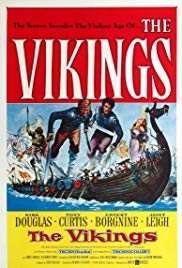
What would be the worst thing for a Viking? Viking Prince Einar (Kirk Douglas) doesn’t know it but his worst enemy, the slave Erik (Tony Curtis), is actually his half brother and their father King Ragnar’s (Ernest Borgnine) legitimate heir. Their feud only intensifies when Einar kidnaps Princess Morgana (Janet Leigh), on her way to be the intended bride of the brutal Northumbrian King Aella (Frank Thring). Einar intends to make her his own. However Morgana has eyes only for Erik – leading to the capture of Ragnar and a terrible final attempt to win her heart ... Let’s not question flesh for wanting to remain flesh. Good looking, well put together and great fun, and that’s just the cast, in this spectacular historical epic, an action adventure produced by Kirk Douglas that capitalises on his muscular masculinity opposite husband and wife team Curtis and Leigh who get to seriously smoulder for the cameras in their love scenes: it was the third of their onscreen pairings. With some very fruity language, mistaken identity, axe-throwing, pillaging, actual bodice-ripping, walking the plank for fun, unconscious sibling rivalry, brawny sailors, death by wolf pit, romance and swashbuckling, this has everything going for it except horned helmets. It might well be about eighth or ninth century Viking lord Ragnar Lodbrok and the probably-real Northumbrian king Aella (who died 867) but it’s really about Kirk and Tony and Janet. Jack Cardiff shoots the expansive Technicolor images, and director Richard Fleischer lets every character have their moment in this fast-paced entertainment. The beautiful tapestry-style animated titles are voiced by Orson Welles and the incredible score is by (paradoxically unsung) soundtrack hero Mario Naschimbene who brings both vigour and mystery to this good-humoured story of war and violence: you will believe that those voices in the sky are coming from the heavens. Adapted by Dale Wasserman from the 1951 novel The Viking by Edison Marshall, with a screenplay by Calder Willingham, this is one of the very best action-adventure films of all time with some great editing by Elmo Williams who also helmed the second unit and made the TV series inspired by it, Tales of the Vikings, also produced by Douglas’ Bryna Productions. Within a few short years Douglas would cement his legend as a Hollywood liberal with the cry, I am Spartacus! but for now it’s Odin!











